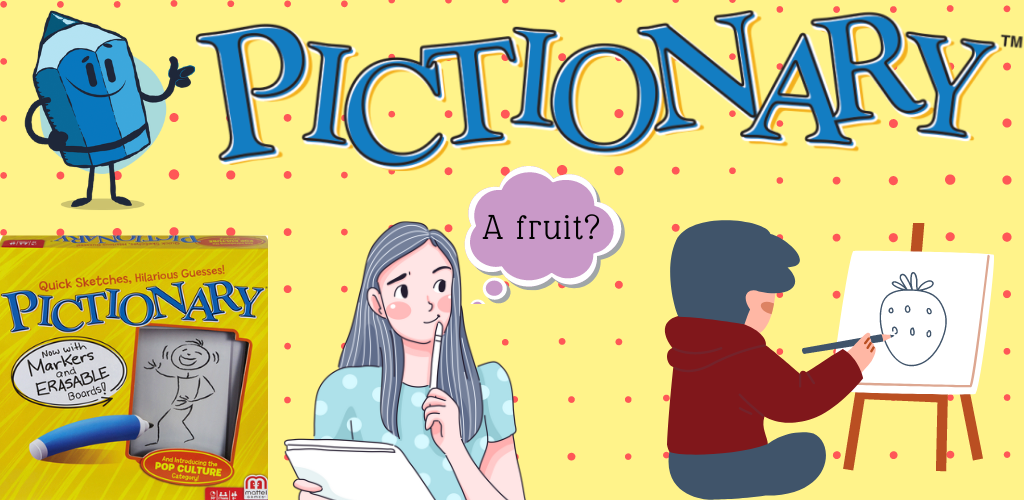About Pictionary
Pictionary is a visual word-guessing game played in teams with players trying to identify specific words from pictures drawn by their teammates. It was first introduced by Robert Angel with graphic design by Gary Everson in 1985. Later, Mattel (a multinational toys and entertainment company) acquired ownership of the Pictionary game in 2001. In this blog, I’ll discuss how to play this fun draw-n-guess game.

Do you know?
- Combing ‘picture’ and ‘dictionary’ made up the word ‘Pictionary’.
- The Pictionary game is for all ages.
- There are multiple versions of Pictionary.
- There isn’t any limit to the players and teams playing this game.
- This game comes in more than 45 languages.
How to play Pictionary?
During the pandemic in 2020, the comeback of board games was evident. Especially for millennial parents working from home who had to come up with options to entertain their kids, Pictionary was one of the trendy games. Nevertheless, board games can never go out of trend, considering Pictionary is a pure fun game. Let’s start with the elements of Pictionary (basic version).
Elements (elements can differ in various versions of the game):
- Game board
- Deck of cards (with words)
- Category cards
- Drawing pad
- Pencil
- Sand timer or any timer
- Two dice
- Movers
Category cards (there are five categories usually; it can also be four categories):
- All Play (AP) – where any word or expression can be used and any team can guess
- Difficult (D) – where the words are a bit harder to represent in a drawing
- Actions (A) – for verbs
- Object (O) – for non-living nouns
- Person/Place/Animal (P) – for living nouns
Objective (goal of the game):
Choose one player on your team to be the ‘Picturist’. The highest rolling team starts the order of play. The player moves a mover piece on the game board formed by a sequence of squares. On your team’s turn, the Picturist has two minutes to sketch the prompted word from a card he drew. If you’re the one sketching, try to quickly sketch the prompt so your team can correctly identify the picture. The objective of the Pictionary game is to correctly identify what the ‘Picturist’ is trying to express through the pictures that they draw and reach the last space on the board to win the game.
Gameplay
- Call all the kids living nearby and separate them into two teams (better if you have six or more players for better entertainment). You can team up with your kid as wished. Ask your kid to be the Picturist to sketch, or you can choose to become the Picturist and let your kid guess the picture.
- Get a pencil, drawing pad, and reference card for yourself and the other children. Since only one team member will be drawing at a time, all you’ll need is a single pencil and pad of paper. Place the reference card so that everyone can access it. Your kid can get a sense of what he’ll need to draw by looking at the card’s list of the colours and classifications for the spaces on the board and other cards.
- Each Pictionary card has a list of five words printed on it related to All Play, Difficult, Actions, Object, Person/Place/Animal, and there are five different kinds of squares on the board. Your child needs to draw the word that corresponds to the board square where the team’s mover is located.
- Ask your kid to pick a card out of a deck of special Pictionary cards and let him try his way to sketch pictures which suggest the word printed on the card. Now everyone should be ready. Once the card is drawn, your kid has 5 seconds before he begins to sketch. Once 5 seconds are up, the timer is set to 2 minutes, and he must sketch the word.
Note: Both the picture and the Picturist are prohibited from including any numbers or letters or from using oral cues to indicate what they are sketching. The team members make an effort to guess the word that the drawing is supposed to represent.
- “All Play” is the name of the AP category. Everyone is expected to guess the AP category. The team that correctly answers the word first receives a point and moves on to the next turn. If no teams correctly guess the word, the turn shifts to the team that ought to have been next.
- Repeat until each player has drawn at least once and one team has ten points.
End of the Game
Make the game fun by doodling the pictures and letting your kid and his friends have fun while they guess the artistic work of their playmates. At the end of the Pictionary game, a team must reach the final Square on the Pictionary board for the chance to win the game. The first team to identify the word during the last round with ten points in hand wins and forget to reward the team with exciting gifts.
Benefits of the Pictionary game
The game of Pictionary helps young children to develop the following:
- Creativity
- Logical thinking
- Mind retention
- Communication skills
- Fun-filled learning
- Enhances vocabulary
- Team building
The benefits of this fun learning game aren’t limited because Pictionary has many versions like Pictionary Card Game, Pictionary Quiz, Pictionary Jr, Pictionary: Showdown, Pictionary Team Relay, Pictionary Air, and many more.
Irrespective of the game rules and variations, you can make your own Pictionary game or Pictionary quiz to make it more accessible and fun learning for your kid as well as for you. If you haven’t played this fun-filled learning game with your kid, perhaps you should Pictionary today!
Also Read…
How Game-Based Learning Benefits Children!



Speak Your Mind
Save my name, email and website in this browser for next time I comment